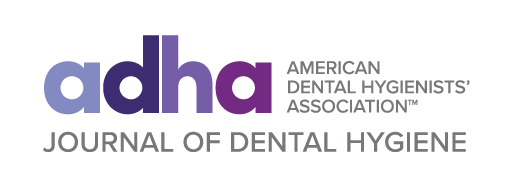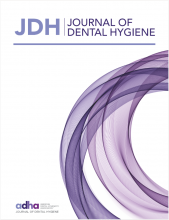
April marks Oral Cancer Awareness Month, highlighting the significant improvement in 5-year survival rates for oral and oropharyngeal cancer over the past several decades. According to the National Cancer Institute survey, 5-year survival rates have increased by approximately 27% from the mid-1970s to the latest survey conducted in 2012-2018, with the overall 5-year survival rate for all stages at 68%.1 Historically, the mortality rate for oral and oropharyngeal cancer has been elevated largely due to challenges in early detection. However, efforts made by oral health care providers to improve cancer screening through comprehensive head and neck and oral cavity examinations has likely played a significant role in improving the 5-year survival rates. Among all oral health care professionals, dental hygienists play a pivotal role in early detection as they see patients more frequently than most other members of the oral health care team. With a strong emphasis on the importance of oral cancer screening, most dental hygienists are likely to incorporate screenings into their routine clinical practice.
Despite overall improvement of the survival rates, significant disparities persist among certain populations. Extensive data highlight the profound impact of racial and socioeconomic factors on oral health and general access to health care throughout life.2,3,4 Expanding access to care for all individuals may be pivotal to enhancing early detection of oral and oropharyngeal cancers with dental hygienists serving as the key contributors to this critical effort.
Advancements in head and neck cancer treatments have also played a significant role in improving 5-year survival rates, leading to more favorable outcomes. However, these advancements can also result in increased treatment-related complications. One of the most common early, and often acute, oral complications is oral mucositis (OM), a painful and debilitating condition characterized by mucosal ulceration. Oral mucositis often causes severe mouth and throat pain making it difficult or impossible to eat and drink, reducing quality of life, prolonging hospital stays, and increasing overall healthcare costs.
Additionally, OM may provide a route for sepsis, a potentially life-threatening complication during myeloablative hematopoietic cell transplantation (HCT). Poor oral hygiene is a major risk factor for worsening OM5 and extensive research demonstrates the effectiveness of oral hygiene protocols in reducing the severity of OM during radiation therapy (RT), chemotherapy, and HCT.6,7 Given this, dental hygienists have a valuable opportunity to take the lead in promoting oral hygiene as a key strategy in preventing severe OM during cancer treatment.
One of the most common late/chronic stage complications of cancer treatments is xerostomia/dry mouth. It can lead to poor nutritional status, increased incidence of dental caries, and oral candidiasis. Historically, RT has been the primary contributing factor to xerostomia among cancer treatments. While technical advancements such as intensity modulated RT and other modern RT planning techniques aim to reduce exposure to the salivary glands, a recent study found that stimulated whole salivary flow remained significantly reduced at only 37% of pre-RT levels 6 months even after modern RT.8
In addition to RT-related xerostomia, the widespread use of immunotherapy has led to a notable increase in patients experiencing severe dry mouth.9 As a result, oral health care professionals are encountering more oncology patients suffering from this condition. While it is well known that hyposalivation increases the risk of dental caries, post-RT patients often experience higher rates of decay than those with dry mouth from other causes, raising the suspicion that other contributory factors may be involved. A recent study has shown that RT for head and neck cancer led to a striking dose-dependent increase in gingival recession.10 Over a two-year study period, the mean distance from the cemento-enamel junction to the gingival margin decreased by 74%.10 Greater gingival recession was also associated with increased caries on the facial/buccal surfaces.10 These findings highlight the elevated risk of cervical caries in this population.10 This presents another critical opportunity for dental hygienists to take a leading role in managing dry mouth and preventing dental complications associated with xerostomia and cancer treatments.
A less common but potentially more serious and challenging complication of cancer treatment is osteonecrosis of the jaw (ONJ). Osteonecrosis of the jaw can result from RT (osteoradionecrosis of the jaw or ORN) or from certain medications (medication-related osteonecrosis of the jaw or MRONJ). Radiation therapy has long been recognized as a risk factor for ORN. While intensity modulated RT can help reduce radiation exposure to the jawbones and lower the risk of ORN, the threat of ORN persists as long as the jawbones receive radiation. Medication-related osteonecrosis of the jaw is associated mostly with antiresorptive and antiangiogenic medications which are commonly used in cancer treatments. Antiresorptives are commonly used medications for metastatic cancer to the bone, as well as certain hematologic malignancies such as multiple myeloma. The risk of MRONJ is significantly higher in cancer patients with one study showing an approximately 10-fold higher incidence rate as compared to patients receiving antiresorptives for osteoporosis.11 Research suggests that optimal oral hygiene and the management of local infections can help reduce this risk. Reflecting this, the Multinational Association of Supportive Care in Cancer (MASCC) and the International Society of Oral Oncology (ISOO) recommend effective oral hygiene as a preventive measure for MRONJ.12 Additionally, these organizations advocate for multiagent oral care protocols to enhance awareness among patients and health care providers, ultimately reducing the severity and frequency of oral complications.13 There are countless opportunities for dental hygienists to contribute for the prevention, management and research in this area.
As advancements in medical oncology lead to higher cancer survival rates, the number of patients experiencing oral complications continues to grow. While many of these complications stem directly from cancer and its treatments, advanced cancer itself can also lead to indirect oral health challenges. Physical issues such as fatigue may hinder the patient’s ability to perform simple oral hygiene tasks and psychological problems such as depression can reduce the motivation for self-care14 Maintaining good oral health is critical in both preventing and managing these oral complications with oral hygiene serving as the foundation for overall good oral health in oncology patients.14 In conclusion, the demand for dental hygienists in oncology is high and continues to grow, and their involvement in oncology care teams will play a crucial role in enhancing the future of cancer care.
- Copyright © 2025 The American Dental Hygienists’ Association
This article is open access and may not be copied, distributed or modified without written permission from the American Dental Hygienists’ Association.








